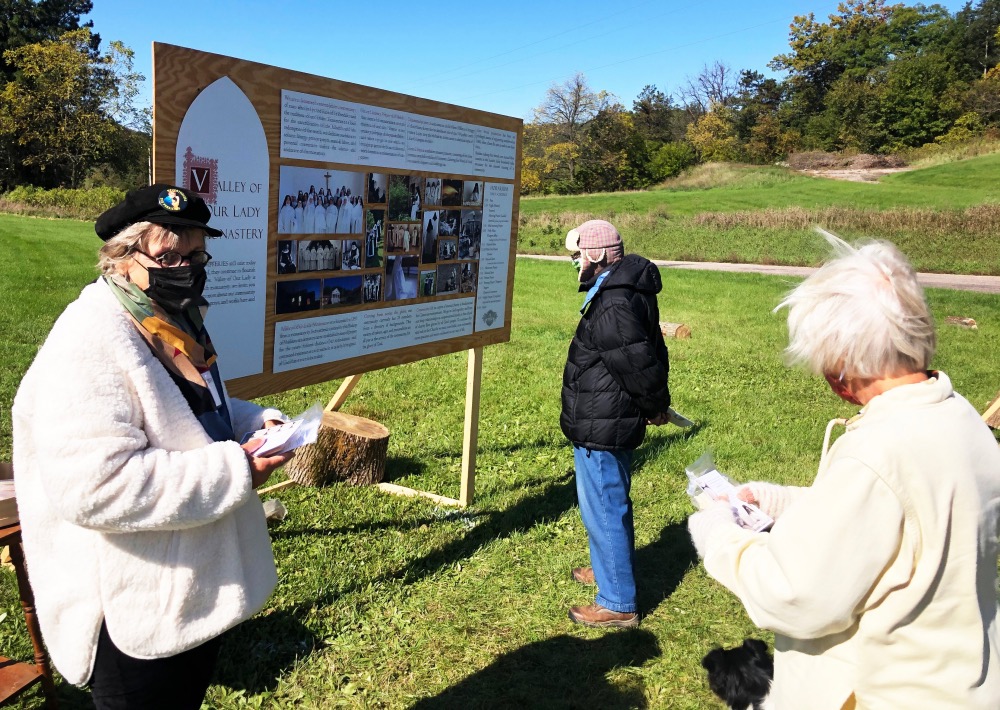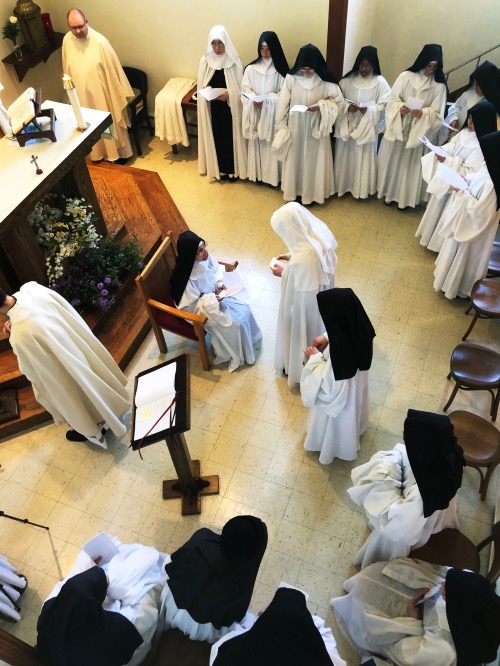
KATELYN FERRAL, writing for Religion News Service, reports on how, amid declines in people attending church, one small community of religious sisters is growing so much they are fundraising to build a bigger home…
Even before the coronavirus pandemic, Sister Mary Bede was no stranger to quarantine life.
Sister Bede and 22 other Cistercian nuns who live with her at Valley of Our Lady Monastery in Prairie du Sac, Wisconsin, are cloistered in silence according to the rule of their ancient monastic Catholic religious order.
Dedicated to constant prayer, the sisters live simply, supporting themselves by baking Communion bread for churches in Wisconsin and as far away as Australia.

Gail Lamberty, a friend of the sisters and volunteer explains the new monastery project for the Cistercians during an open house at Valley of Our Lady Monastery in Prairie du Sac for the public in October, 2020. PICTURE: RNS/Katelyn Ferral
The Prairie du Sac Cistercians may be in sync with Americans’ isolation during the pandemic, but in every other way they are an exception to contemporary culture: As fewer people attend Christian churches each year and with even fewer entering Catholic religious life, their community is growing. What’s more, millennials make up more than one-third of its members.
At 23 women, its community, the only one of its kind in the country, isn’t huge, but its current buildings are at capacity. The nuns are now fundraising to build a new home.
“The layout just isn’t conducive to the monastic life. We shouldn’t be living in a governor’s summer house for a monastery. They never intended it to be the final home.”
– Sister Mary Bede, speaking of the community’s current home at Valley of Our Lady Monastery in Prairie du Sac, Wisconsin.
The current monastery is a cobbled-together complex that includes a former Wisconsin governor’s summer home dating back to the 1920s. Valley of Our Lady was founded in 1957 when six nuns from a Cistercian monastery in Frauenthal, Switzerland, emigrated to the area. The women who founded the community never intended for their current space to be a permanent monastery, Sister Bede explained.
“The layout just isn’t conducive to the monastic life. We shouldn’t be living in a governor’s summer house for a monastery,” said Sister Bede. “They never intended it to be the final home.”
The Cistercian sisters are working to raise $US18 million for a 54,000-square-foot monastery, which will sit on 229 acres in rural Iowa County, southwest of Prarie du Sac. It will include a chapel, living quarters for 30 sisters, offices, a guest house and a more efficient bakery space for their bread operation.
The buildings will be grouped around a quadrilateral, a form meant to encourage contemplative dialogue with God. Being among nature also encourages that. “To stand still and wonder at a dragonfly, at a dandelion…the wonder and the contemplation very much go hand in hand,” said the Cistercians’ prioress, Sister Anne Marie.
A D V E R T I S E M E N T
{subscriber-ad}
Rev Andrew Showers, a priest in the Diocese of Madison who studies sacred architecture, said, “Architecture is the built form of ideas, so a building should manifest the ideas, the philosophy; so the thought is that anyone can walk into a church and can understand what it believes and how they worship God based on how they build their building.”
The structure of a church or a monastery is meant to be “based on the Incarnation: that God wanted to come meet us in time and space,” he added.
Building a new monastery is exceedingly rare, says Kevin Clark, the architect for the project who started working with the sisters on it in 2017. “Less than a handful of monasteries have been designed and built in the last 40 to 50 years,” says Clark, who is based in Lincoln, Nebraska. “To start from scratch is a real dream.”
The project is a large one because the monastery encapsulates the sisters’ whole life, Clark says. “This is an entire town we’re building. We’re building their chapel, their office building, their dining room, the housing, and their industry being their factory…It’s everything they will need or use for their lives,” he said.

The Cistercian sisters of Valley of Our Lady Monastery gather in their current chapel for the final vows of one of their members, Sister Joanna Casanova in May, 2018. PICTURE: RNS/Katelyn Ferral
A thousand years ago, monasteries played crucial roles in rural areas where they served as beacons for travellers, offering running water, medical care and a safe haven, Clark said.
Today, building a space that is a testament to prayer where people can experience silence and peace is something that is still vital, according to the sisters.
Cistercians are known as “lovers of the place,” and the community inside the monastery is dedicated to the one outside of it, Sister Anne Marie explained.
“To know that there are people out there constantly raising up the needs of our society in prayer is awesome,” Clark said. “So, do we need monasteries? I would say ‘yes.’ I can tell you I didn’t quite understand it when the project started, but getting to see it and be a part of it is pretty awesome.”
The new monastery will be austere by design, in accord with both traditional Cistercian architecture and the nuns’ vow of poverty. Many of the techniques the monastery’s builders will use hearken to monasteries of the Middle Ages. Lou Host-Jablonski, the nuns’ sustainability architect, is looking at ways to build as ecologically responsibly as possible, both in the materials used and where the buildings will sit on the property.
The hope is to integrate geothermal energy to heat water, use gray water, take full advantage of natural lighting and position the buildings on the land to protect the sisters from the wind while making the best use of it for energy.
In medieval times, said Host-Jablonski, “you designed sustainably because you didn’t have computers and smartphones and UV panels; you didn’t have electricity; you didn’t have pumps.
“As a building owner you make 10,000 choices; every one of those choices has some ecological impact…All of those things are about choices that (the sisters) take seriously through the lens of stewardship. Stewardship is profoundly ethical, profoundly moral.”
Prior to the pandemic, Sister Bede did most of the fundraising work from the monastery but occasionally traveled to talk to congregations and organizations around the country. Now those trips are on hold for the foreseeable future.
Several donors have contributed large gifts, including two in the seven figures, but the majority are smaller.
“We know people are not doing well…and there are a lot of layoffs. But the response to our continued fundraising has been encouraging. God’s ways are not our ways, and so he seems still to be blessing our efforts.”
– Sister Bede
“We know people are not doing well…and there are a lot of layoffs,” says Sister Bede. “But the response to our continued fundraising has been encouraging. God’s ways are not our ways, and so he seems still to be blessing our efforts.”
One of those blessings is a matching gift challenge: The monastery is now trying to raise $US1 million before April of 2021; if the sisters achieve this goal, an anonymous donor will match it.
With the hope that 2021 is a better year than this one, the prayer at Valley of Our Lady will continue, regardless of what happens.
“Isn’t it good that there are pockets throughout the whole world where the only reason for people being there is to praise God and intercede for the people?” Sister Anne Marie said.
“Obviously we’re all here very much believing in the power of prayer and the need for it.”





